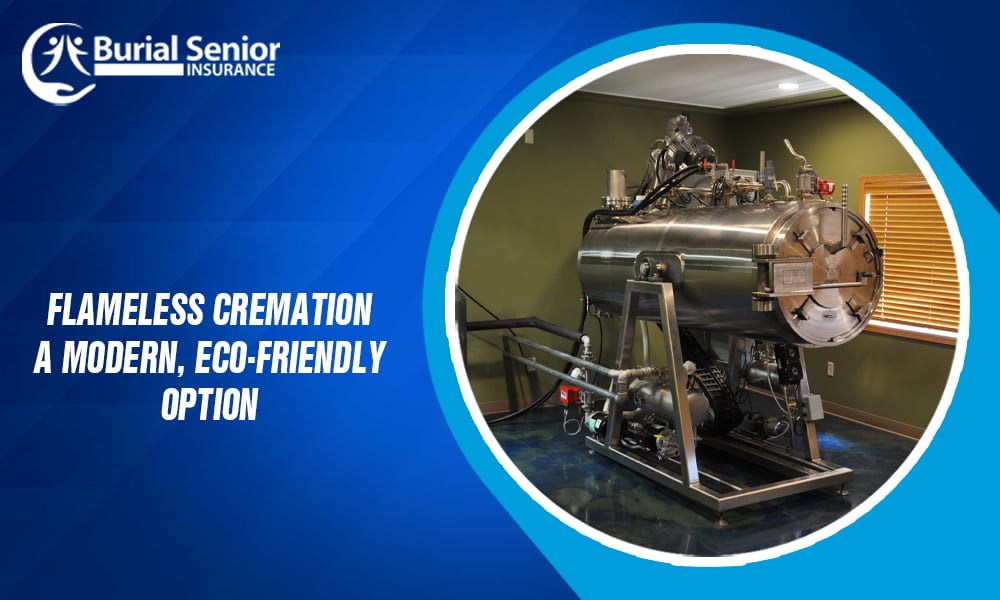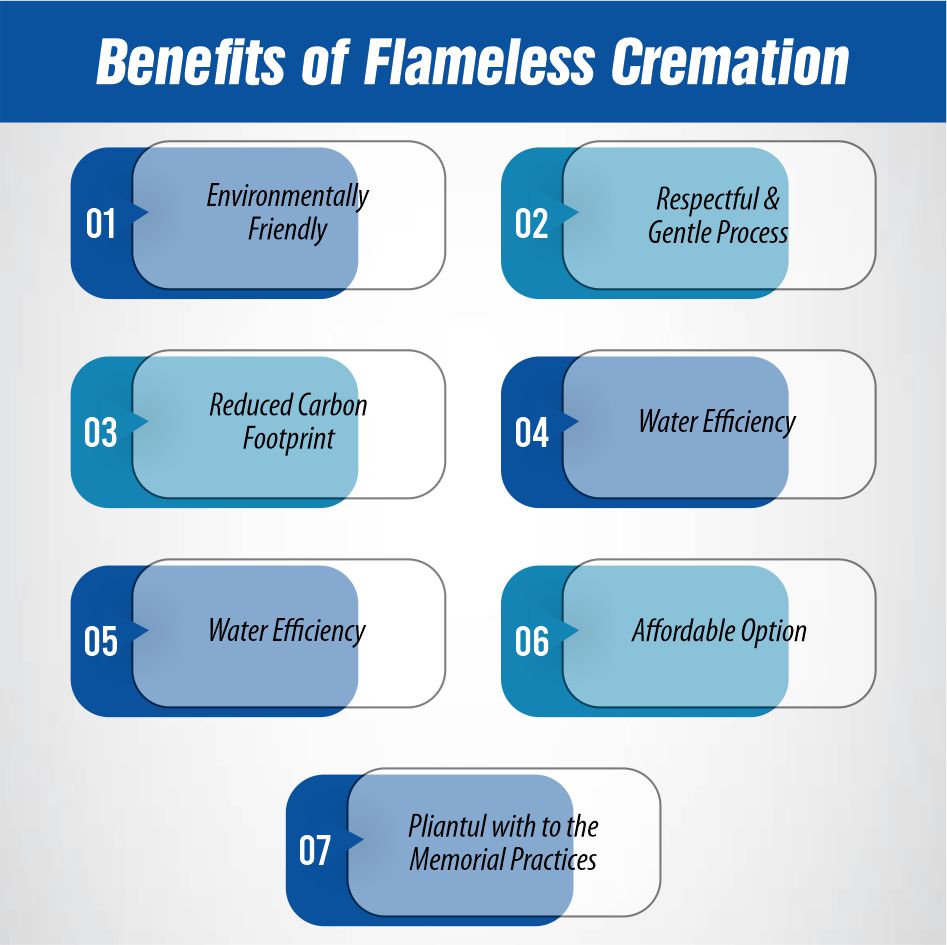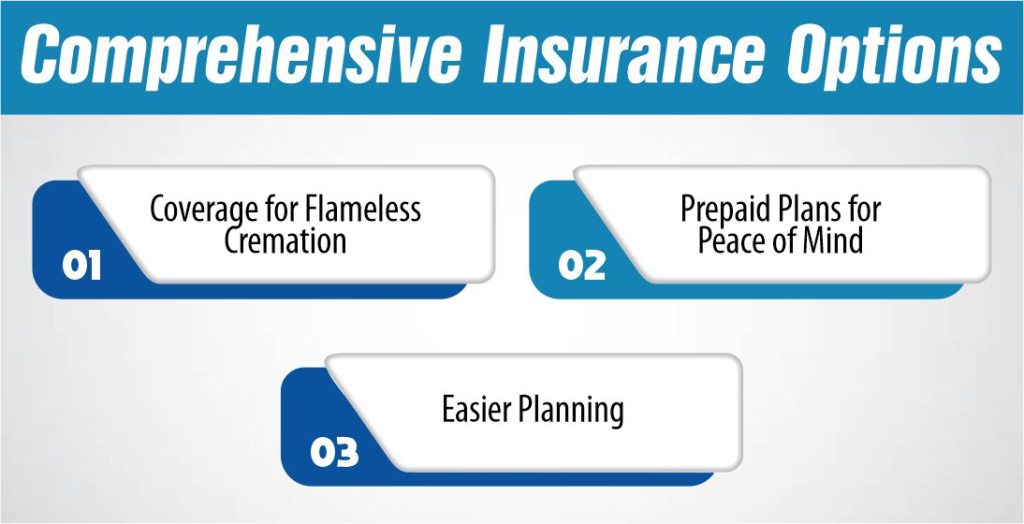Last Updated on: March 10, 2025
Reviewed by Kyle Wilson

Alkaline hydrolysis, another name for flameless cremation, is a non-toxic cremation method. Flameless cremation is different from traditional cremation, which is done by fire, flame is displaced by water, heat, and alkalis. This process is steadily gradually claiming popularity for being environment and, in addition, for being an innovative approach to paying tribute to deceased family members.
Get Free Quotes
Customized Options Await
Water cremation is a technique that instead of using fire burns bodies and reduces them to their elements. It is generally regarded as an environmentally friendly process in that it requires less energy and leads to lower levels of emissions than traditional cremation. This solution is a more decent and sustainable one for families that are in search of some new style.

Alkaline hydrolysis, or flameless cremation, is another form of cremation that has more humane processes and is increasingly being embraced mostly because of its environmentally friendly nature. This method has several advantages, which make this process thoughtful and modern for families. Here are some of the key advantages:
Compared to the common method of cremation, flameless cremation is a greener solution. Compared to the traditional approach, which releases toxic gases like carbon dioxide and mercury into the atmosphere, flameless cremation does not. It requires much less energy as a result making it a better, friendlier product to the environment for individuals seeking to reduce their environmental footprint. That is why this concept is quite popular with families that want to protect the environment and live in an environmentally friendly manner.
The flameless cremation process is intentionally cremated in a very honorable and sacred manner as well as to the deceased. But in reality, using water, heat, and some alkali reagents, the body is disassembled into its components as carefully as possible. This…) This modern method offers an appropriate and serene means of bidding farewell to the deceased’s body with a lot of respect to the remains being processed. To families, it assures that their family member is being respected in a nonconspicuous method.
Strictly compared with traditional cremation, flameless cremation reduces the environmental footprint. This causes a lot of heat and hence reduces the chances of using burning fossil fuels and other toxic gases to help cremate a body, thus acting as a conservation method that eradicates the chances of adding to the creation of the greenhouse effect. More to the point, flameless cremation service is an environmentally sensitive option for those who wish to avoid fueling the controversial cause of cremation. This makes it quite attractive for anyone and or family that considers the environment a paramount importance.
One of the strongest advantages of flameless cremation is its water consumption advantage. Flameless cremation on the other hand has been established as using only a small amount of water, unlike other elaborate burials that may use large amounts of water. The water used during the entire process is treated with high levels of care and is fully restored to the water production system without any polluting the environment in the process. This responsible water management is beneficial for the whole process guaranteeing maximal sustainability.
As a rule, flameless cremation may be cheaper than traditional one. They are more efficient in energy use as compared to traditional burial and also exempt losses such as huge funerals, caskets, and vaults. This makes them a preferred choice for families that wish to spend a decent amount of cash at the end of their lives but without struggling financially. Also, it can be melded with other plans like direct cremation insurance that will only benefit families in terms of the budget they are willing to spend for it knowing that they also want to have financial freedom.
Technically, flameless cremation is a different process from the conventional cremation process, but what is returned to the family is fine powder known as cremains. This way families can continue with common burial traditions including; spreading the ashes, placing them in a commemorative urn, or having them in memorial merchandise. Flameless cremation has similar premising positions that allow freedom and various choices just like the conventional funeral processes to ensure that memorial services and rituals can still be satisfactory and dignified for the dead.
Green flameless cremation is a relatively new solution as an end-of-life process that has been developed to reduce as many detrimental effects on the environment as possible. This method is also referred to as alkaline hydrolysis or aquamation and more preferable as a green method for handling cremation.
Opposed to the conventional cremation which involves burning and fire and requires a huge amount of fossil fuel, the green flameless cremation breaks down the body of a deceased person with the aid of heat, pressure, water, and an alkaline solution. It helps does not emit toxic fumes, including carbon monoxide and mercury, usually emitted by flame-based cremation.
This unlike combustion does not release gaseous greenhouse substances, soot, or other toxic pollutants hence safer for the atmosphere.
Flameless cremation therefore consumes far less energy than it does in traditional cremation due to high temperatures. These lead to decreased energy use which is good for the environment in terms of reduced emissions of carbon dioxide.
The process involves the utilization of a limited amount of water which is recycled and returned to the water cycle. It makes optimal use of water resources while at the same time preserving the environment as well.
Supporters of the green flameless cremation are aware of their capabilities of providing a more environmentally friendly method, which is also in line with families’ beliefs.
Green flameless cremation is the perfect option for any person, who wants to give a proper send-off whilst at the same time doing it for the good of the planet and future generations. It lets families make informed choices that will respect their dear ones and still lead to a better quality of life.
Category | Details | Price Range |
Flameless Cremation Cost | Prices vary depending on the service provider, location and included services. | $2,000 – $3,500 |
Location Impact | In Florida, costs are generally lower than in some other states, offering an affordable option. | $2,000 – $2,800 |
Comparison to Traditional Cremation | Flameless cremation (alkaline hydrolysis) is typically comparable or slightly higher in cost than traditional cremation due to its eco-friendliness. | Traditional cremation: $1,500 – $2,500 |
Additional Services | Options like urns, memorial services, or transportation can increase the overall cost. | $200 – $1,000 (add-ons) |
Cremation Insurance Options | Families can offset costs with cremation insurance policies specifically designed for seniors or those seeking affordable solutions. | Premiums: $10 – $50/month |
From the following table, one can easily get the details of flameless cremation and likely costs. Please let me know if you would like them to concentrate on other aspects!
As a progressive approach to conventional burial and cremation services, flameless cremation or alkaline hydrolysis is immensely popular in Florida. It has also been embraced as an environmentally friendly and cheaper method, for this reason, many families in the state have preferred this method.
The flameless cremation that the company promotes caters to the aspect of sustainability, a factor that is dear to the hearts of most Floridians. This process cuts on the emission of noxious substances, conserves energy, and does not emit environmentally unhealthy substances and as such makes it ideal in a state where the issue of environmental conservation is highly valued.
Hydromereation is a unique system whereby the body is processed through water instead of fire, greatly honoring the remains and producing an end product of cremated ashes in an environment that is indeed flameless. These modern undertakings retain culture’s pull towards the families who wish to respect their deceased kin without stiff practices.
Flameless cremation is less expensive than conventional cremation or burial, and can therefore be cheaper than before in some regions of Florida where funeral expenses are soaring. Financial savings can still be enhanced by purchasing direct cremation insurance, because it commonly includes flameless cremation, thus giving families complete tranquility.
There is a large number of providers in Florida that provide flameless cremation services due to the increasing popularity of this environmentally friendly solution. Throughout the state, progressive funeral homes and crematories make this service option available to families.
Some of the Florida direct cremation insurance plans often have flameless cremation, which offers families a convenient and inexpensive method of arranging for final days services. These policies assist in defraying the expenses that would be incurred in the process, giving families ample time and little worry about having to make arrangements for their dear ones.
Alkaline hydrolysis or flameless cremation is an alternative to traditional cremation or burial that families will likely find irresistible for the following reasons. This innovative and GLOBAL choice along with the aspects of the costs that go with its sustainable structure make this one of the most pragmatic and – let’s not shy away from the word – ethical choices for those who would choose its important qualities in deciding on how to die. Here’s a more detailed look at why flameless cremation might be the right option for you:
Flameless cremation makes it one of the most environmentally friendly options for people and families who are devoted to saving the world. Here’s how it benefits the environment:
Ott Lights also known as flameless cremation is a revolution in the funeral and end-of-life care services industry. Its concept is a chemical and biological one that uses water, an alkaline solution, heat, and pressure as ways to create a delicate process of the human body decomposition. Here are the key reasons why it’s a modern solution:
Flameless cremation is usually cheaper than conventional cremation and burial since the latter incurs some expenses like caskets, embalming, burial space, and gravestones. Here’s how it provides an accessible and cost-effective solution:

Cremation is on the rise, so many insurance policies existing today are those that would pay for funeral and cremation services, including flameless cremation services. There are however options that make this decision easier to make for families and one of them is the direct cremation insurance. Key benefits include:
Selecting flameless cremation one can receive a certain sense that helps to overcome the sorrow not only because of the environmental issue but because it is more honorable and tender to the body of the deceased person. The families that opt for this option can be relieved knowing that they have made a decision that is right for them, safe for the environment, and cheap at that during one of the worst moments.
This innovation of flameless cremation provides a sorely needed solution for respecting our cherished dead and the earth they inhabited. Its civil, non-harm environment way enables families and friends to bid the deceased special farewell. Thus, the families can make a decision based on the process, benefits they are aware of, and costs they are willing to bear.
Flameless cremation, or alkaline hydrolysis, also called water cremation, is less damaging to the environment than typical flame cremation. It involves the use of heat, water, and alkaline solutions in the breakdown of the remains the resultant product is …ash like that produced by cremation.
Yes, flameless cremation is actually legal in many states across the United States, but the laws that allow for cremation can be somewhat different depending on what state in ts you are in. It so all one can do is to confirm from his locality if it avails their laws and regulations to make it accessible.
Of course, it is 100% safe for the environment and for everybody who participates in it. It does not emit dangerous gases such as conventional cremation and consumes less power.
Flameless cremation normally lasts between three to four hours; however, traditional cremation may also take several hours.
Subsequently, the remaining fragments of the bones are grounded into very fine ash, and just like cremation, the ashes can be returned to the family. The ashes can be kept, buried, or scattered depending on the behest of the surviving family members.
Senior Writer & Licensed Life Insurance Agent
Iqra is a dynamic and insightful senior writer with a passion for life insurance and financial planning. With over 8 years of hands-on experience in the insurance industry, Iqra has earned a reputation for delivering clear, actionable advice that empowers individuals to make informed decisions about their financial future. At Burial Senior Insurance, she not only excels as a licensed insurance agent but also as a trusted guide who has successfully advised over +1500 clients, helping them navigate the often complex world of life insurance and annuities. Her articles have been featured in top-tier financial publications, making her a respected voice in the industry.

Burial Senior Insurance provides information and services related to burial insurance for senior citizens, including policy options and end-of-life support services.
Copyright © Burial Senior Insurance 2025. All Right Reserved.

Get Free Life Insurance Quotes